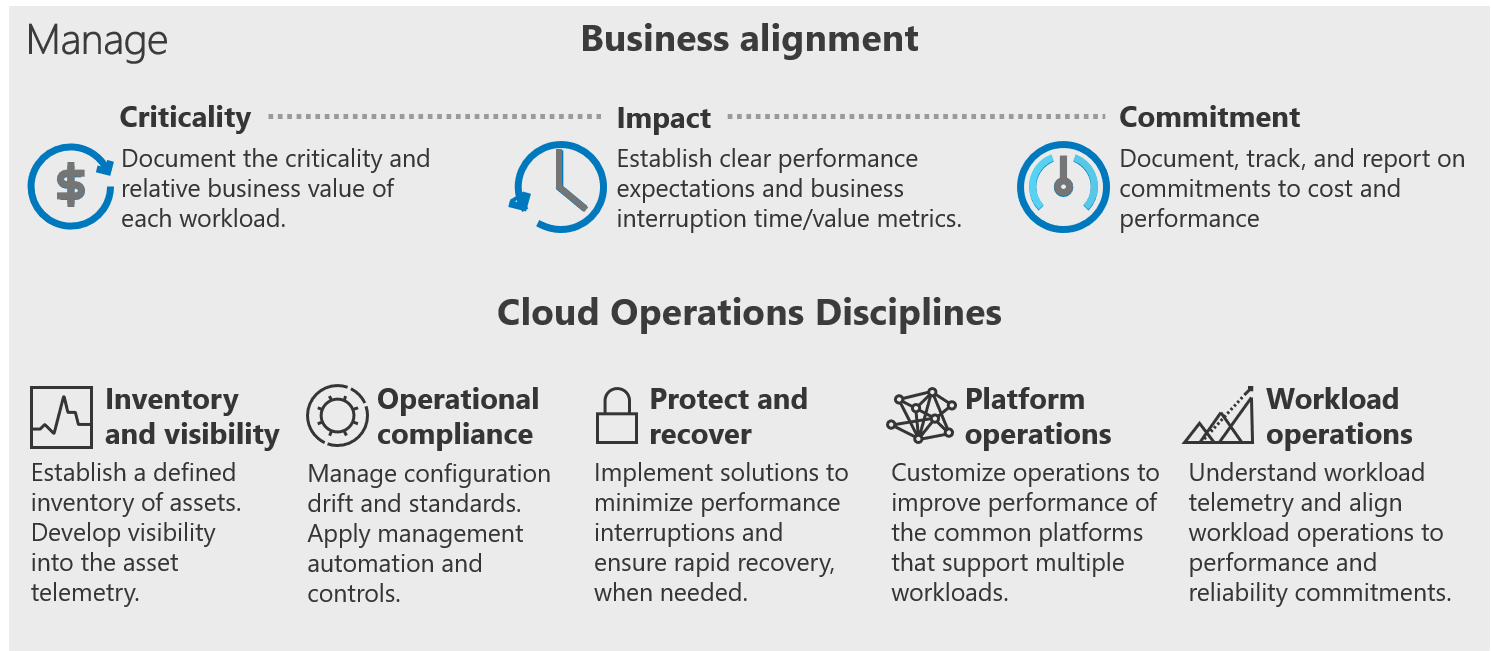Cloud management in the Cloud Adoption Framework
Delivering on a cloud strategy requires solid planning, readiness, and adoption. But it's the ongoing operation of the digital assets that delivers tangible business outcomes. Without a plan for reliable, well-managed operations of the cloud solutions, those efforts will yield little value. The following exercises help develop the business and technical approaches needed to provide cloud management that powers ongoing operations.
Get started
To prepare you for this phase of the cloud adoption lifecycle, the framework suggests the following exercises:
Define business commitments: Document supported workloads to establish operational commitments with the business and agree on cloud management investments for each workload. |
|
Establish a management baseline: Define the criticality classifications, cloud management tools, and processes required to deliver your minimum commitment to operations management. |
|
Expand the management baseline: Based on business commitments and operations decisions, make use of the included best practices to implement the required cloud management tooling. |
|
Advanced operations and design principles: Platforms or workloads that require a higher level of business commitment might require a deeper architecture review to deliver on resiliency and reliability commitments. |
The preceding steps create actionable approaches to deliver on the Manage methodology of the Cloud Adoption Framework.

As discussed in the business alignment article, not all workloads are mission critical. Within any portfolio are various degrees of operational management needs. Business alignment efforts aid in capturing the business impact and negotiating management costs with the business, to ensure the most appropriate operational management processes and tools.
The guidance in the manage section of the Cloud Adoption Framework serves two purposes:
- Provides examples of actionable operations management approaches that represent common experiences often encountered by customers.
- Helps you create personalized management solutions based on business commitments.
This content is intended for use by the cloud operations team. It's also relevant to cloud architects who need to develop a strong foundation in cloud operations or cloud design principles.
The content in the Cloud Adoption Framework affects the business, technology, and culture of enterprises. This section of the Cloud Adoption Framework interacts heavily with IT operations, IT governance, finance, line-of-business leaders, networking, identity, and cloud adoption teams. Various dependencies on these personnel require a facilitative approach by the cloud architects who are using this guidance. Facilitation with these teams is seldom a one-time effort.
The cloud architect serves as the thought leader and facilitator to bring these audiences together. The content in this collection of guides is designed to help the cloud architect facilitate the right conversation, with the right audience, to drive necessary decisions. Business transformation that's empowered by the cloud depends on the cloud architect to help guide decisions throughout the business and IT.
Each section of the Cloud Adoption Framework represents a different specialization or variant of the cloud architect role. This section of the Cloud Adoption Framework is designed for cloud architects with a passion for operations and management of deployment solutions. Within this framework, these specialists are referred to frequently as cloud operations, or collectively as the cloud operations team.
If you want to follow this guide from beginning to end, this content aids in developing a robust cloud operations strategy. The guidance walks you through the theory and implementation of such a strategy.
You can also apply the methodology to establish clear business commitments.
Feedback
Kommer snart: I hele 2024 udfaser vi GitHub-problemer som feedbackmekanisme for indhold og erstatter det med et nyt feedbacksystem. Du kan få flere oplysninger under: https://aka.ms/ContentUserFeedback.
Indsend og få vist feedback om